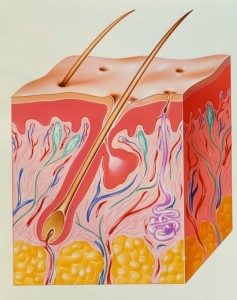 The skin is particularly susceptible to the harmful effects of oxidation [1]. Normally, the skin is protected from the effects of oxidative stress by primary anti-oxidants that are generated by the body. These innate anti-oxidants act to combat the damaging effects of highly reactive free radicals and ultraviolet (UV) rays [2]. While the body normally produces a stream of anti-oxidants to neutralise the free radicals that are constantly being generated from metabolic activities, ageing appears to weaken this line of defense. Furthermore, in times of stress, pro-oxidants are excessively generated, adding to cellular damage.
The skin is particularly susceptible to the harmful effects of oxidation [1]. Normally, the skin is protected from the effects of oxidative stress by primary anti-oxidants that are generated by the body. These innate anti-oxidants act to combat the damaging effects of highly reactive free radicals and ultraviolet (UV) rays [2]. While the body normally produces a stream of anti-oxidants to neutralise the free radicals that are constantly being generated from metabolic activities, ageing appears to weaken this line of defense. Furthermore, in times of stress, pro-oxidants are excessively generated, adding to cellular damage.
Tocotrienol in Overall Skin Wellness
Skin Depigmentation
Among the ingredients used in skin care, tocotrienol is one of the well-studied natural anti-oxidants, whose safety and efficacy is clinically tested and proven. Researchers from Davos Life Science investigated the depigmentation effects of tocotrienols and found that tocotrienol was far more effective than common agents, like kojic acid, in reducing melanin formation. A much lower concentraton (over 150 times lower) was needed to achieve a similar effect. Synergistic effects have also been noted when tocotrienol was given as a co-treatment with other skin whitening ingredients. [3]
Sun Care Protection (Photoprotection)
Due to ultraviolet (UV) radiation which is found in sunlight, excessive and prolonged sun exposure can indirectly cause severe skin damage through increased production of free radicals [4]. Results from a study conducted in 30 patients with photosensitivity showed that topical application of formulations containing tocotrienol provides photoprotective effects with reactions to irradiation (redness, swelling and itchiness) shown to be significantly reduced in the treatment group. [5]
Tocotrienols – Anti-Skin Cancer Mechanisms
In addition to its ability to penetrate the skin’s deepest layers and neutralize the damaging effects of UV-induced free radicals, tocotrienol acts on key proteins within skin cancer (melanoma) cells to induce cell death to help prevent cancer growth. Moreover, tocotrienol when given in combination with an anti-cancer agent enhances the response of melanoma cells to the drug [3].
Read Top Articles
4. Burke KE. Photoaging: the role of oxidative stress. G Ital Dermatol Venereol. 2010. 145(4): 445-59.
